
2018下半年高中英语教师资格证面试试题(精选)第三批
时间:2019-10-12 17:30 来源:未知
- 【考试公告】2020年上半年教师资格证考试公告
- 【报名入口】2020年上半年教师资格证报名入口
- 【备考资料】教师资格证笔试资料免费领
- 【公益讲座】教师资格证笔试免费公开课
- 【辅导课程】教师资格证笔试课程
- 【每日一练】每日打卡
高中英语 语法
一、考题回顾
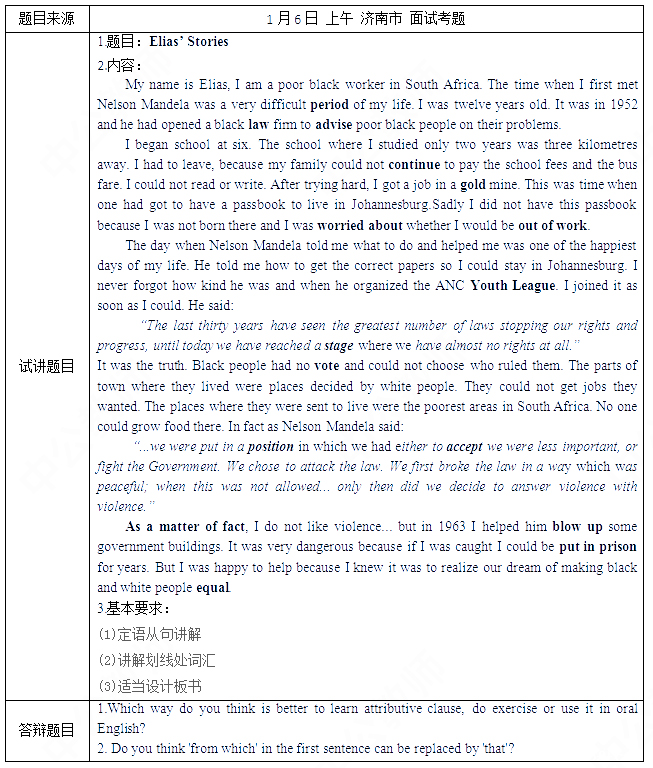
二、考题解析
【教案】
Teaching aims:
Knowledge aims:
(1)Students are able to master the meaning of bold words and phrases: period, law, advise, gold, worried about, out of work, Youth League, stage, stage, position, as a matter of fact, blow up, put in prison, equal
(2)Students can master the usage of adverb in attributive clause.
(3)After this lesson, students can know the difference of usage of adverb in attributive clause and the usage of pronoun in attributive clause.
Ability aim:
After this lesson, students can use grammar of attributive clause in reading and writing.
Emotional aim:
Students are able to love learning English after this lesson.
Key and difficult point:
Key Point: master the meaning of words and phrases :period, law, advise,gold,worried about etc.
Difficult Point: use grammar of attributive clause in reading and writing
Teaching procedures:
Step 1: Warming-up
1. Greetings.
2. Ask students to make several sentences using the grammar of usage of pronoun in attributive clause. Then write a sentence needing to use adverb in attributive clause. And then lead in the new grammar, adverb in attributive clause.
Step 2: Presentation
1.Ask students to open the book and read the passage to guess the meaning the bold words and then paraphrase the bold words with the help of PPT.
2. Then Ask students to find out more complex sentences that the clause is after a noun or pronoun and the words that are used to introduce the sentences: where, when, why or preposition plus which.
The time( when I first met Nelson Mandela )was a very difficult period of my life.
The school (where I studied only two years) was three kilometres away.
This was time (when one had got to have a passbook )to live in Johannesburg.
we were put in a position (in which we had either to accept we were less important, or fight the Government). ...
Then ask students to find the similarity of these sentences and invite several students to share their ideas. Then lead the students to conclude the rules of relative adverb in attributive clause and preposition plus which in attributive clause. (They all function as adverbials)
Step 3: Practice
1.Make sentences: Ask students to use the grammar that has just learnt to describe the pictures which are presented on the PPT.
2.Combine the sentences: Ask students to combine the sentences according to the grammar in attributive clause.
(1)This is a book. Its cover is blue. (whose)
(2)He is the teacher. He helped me. (who/that)
(3)Beijing is the place. I was born in this place. (where/ in which)
(4)This is the hotel. You will stay at the hotel. (where/at which)
Step4: Production
1.Make stories: Ask students to use the grammar that has just learnt to describe the video.
2.Discussion: Ask students to tell their daily life to use the grammar that has just learnt. And after 5minutes to invite several students to share their daily life.
Step5: Summary and Homework
Summary: ask a student to conclude the content of the lesson and summarize with the whole class.
Homework: write a short passage about his daily life using the grammar that has just learnt.
Blackboard design:
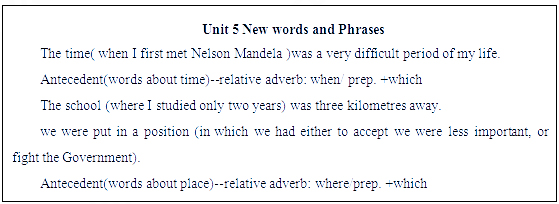
【答辩题目解析】
1.Which way do you think is better to learn attributive clause, do exercise or use it in oral English?
【参考答案】
(1)I think, first, the best way to learn attributive clause is tell the definition of this grammar in
sentence. For example, this is a beautiful teacher (who wears the red dress )is our teacher. Then ask students to pay attention to the clause to find the features of this sentence and conclude the attributive clause: noun/pronoun plus a whole sentence. Next tell the usage of pronoun in attributive clause. Last, teach the usage of adverb in attributive clause.
(2) Exercise and oral English should use togerther in practice attributive clasue. Doing exercise can make students master the structure of this grammar easily. And oral English can make students know the real situation of attributive clause in our daily life.
2. Do you think 'from which' in the first sentence can be replaced by 'that'?
【参考答案】
No, I don’t think. From which is an relative adverb from the point of grammar. And that belongs to the pronoun. So it only can be used as the subject, object and so on but can not be used as the adverb or as as phrase. And this sentence doesn’t have the adverb, so we must use from which.
2018年下半年教师资格面试-英语学科-试讲-考题解析
高中英语 阅读
一、考题回顾
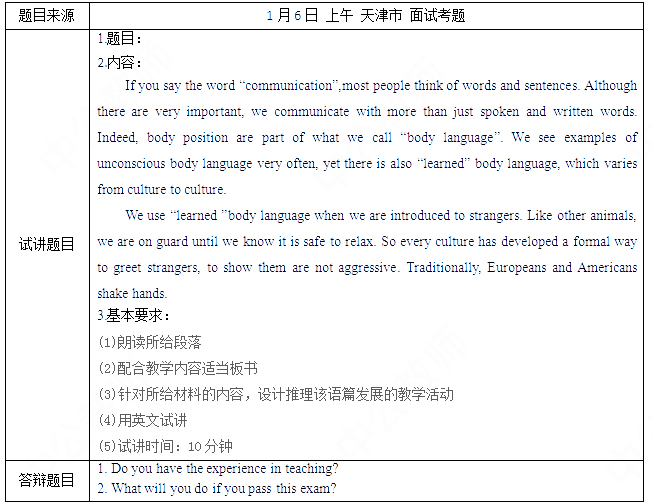
二、考题解析
【教案】
Teaching aims:
Knowledge aim:
Students can know the basic meaning of passage and are able to master the different greeting for the strangers.
Ability aims:
Students can practice guessing content of next paragraph according to the clues which is given in the passage.
Emotional aim:
Students are able to love learning English and like to read different English passage after this lesson.
Key and difficult point:
Key Point: guess the content of next paragraph according to the clues and know the “learned” body language, especially different greetings
Difficult Point: improve students’ reading interest.
Teaching procedures:
Step 1: Warming-up
1. Greetings.
2. Play a video about Chaplin’s mime and ask students several questions:
What kind of body language can you see from this video?
Do you know the meaning of these body language?
Step 2: Pre-reading
Present the passage on the screen and read it for all the students. Before reading, ask students one question: What’s the main ideas of these two paragraphs? And guess the main to topic of this lesson?
Then invite several students to share their ideas.
Step 3: While-reading
1.Lead the students to think one question: Is this a whole passage? And ask students to scan the whole passage and give the teacher answer.
2.Ask students to discuss in group and after 10 minutes to invite several students to share their ideas with all the students.
3.And different students may be just guess the content of several paragraphs. So give students a chart, ask them to finish discussing in 5 minutes. Then invite two representatives to state the whole passage.

Step4: Post-reading
Guessing game: Present another passage on the screen. And give students 10 minutes to read and discuss.Then make a chart and tell your own stories according to chart in your own group .Then invite the representatives to make a report for the whole class.
Step5: Summary and Homework
Summary: ask a student to conclude the content of the lesson and summarize with the whole class.
Homework: Present a passage and ask students to read and write a short passsage,which will be put behind of last paragraph.
Blackboard design:
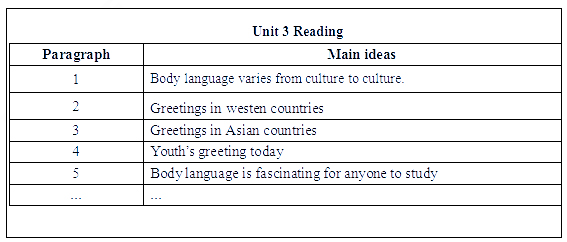
【答辩题目解析】
1.Do you have the experience in teaching?
【参考答案】
Yes, I do. I have taught a teenager in high school. She was the junior. I mainly taught her grammar. I found her grammar was not very systematic. So I taught her from the grammar in words to the grammar in sentences in order to make her master the whole grammar, especially those always appeared in her exams. And during the teaching, I find the most important that it is the teacher should have a better understanding of the whole grammar and the high school English course. Besides, the teacher should pay more attention to the patience. It will make students relax when their learning and get along with the students.
2. What will you do if you pass this exam?
【参考答案】
First, I will find a teaching job to practice my teaching ability. And at the same time to prepare the teachers’ exams for school. When I prepare, I think the most important it’s to know the content of text in high school and do many exercises to practice these knowledge.
Second, I will visit some good teachers who is teaching the high school and learn some experience and practice my teaching ability.
Last, I need to reflect myself to improve my knowledge and my teaching procedures.
2019年上半年教师资格面试-英语学科-试讲-考题解析
高中英语 阅读
一、考题回顾
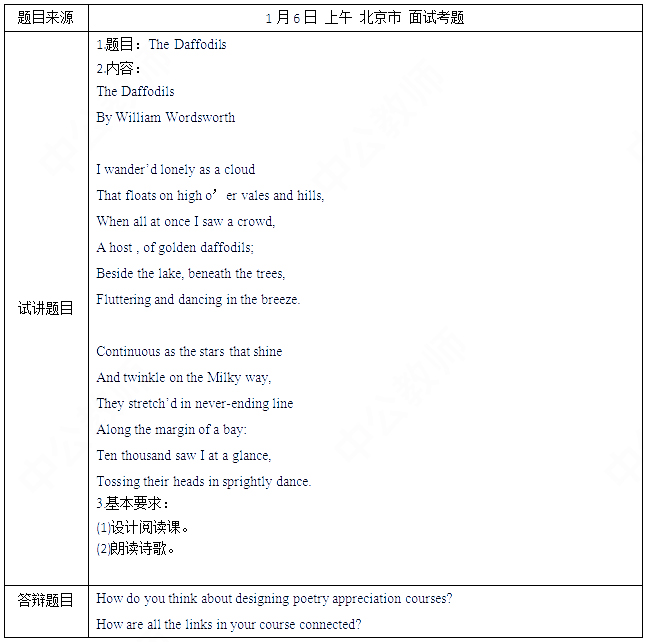
二、考题解析
【教案】
Teaching aims:
Knowledge aim:
Students will have a basic understanding of Wordsworth and the meaning of the poem.
Ability aim:
Students will have their own comprehension of the poem.
Emotional aim:
Students will be interested in reading poems and their confidence will be built up.
Key and difficult point:
Key Point: Students will master some new words from the poem such as vale, daffodil, etc.
Difficult Point: Students will understand the emotions that poetry wants to express.
Teaching procedure:
Step 1: Warming-up
1. Greetings.
2. Sing a song, She walks in beauty, which is also a poem written by Byron.
Step 2: Pre-reading
1. Introduce the major English Romantic poet William Wordsworth.
2. Introduce the background of the writing of this poem.
Step 3: While-reading
1. Read the poem for students, let them underline the words they don’t understand. And teacher explain the meaning by giving some example sentences.
2. Ask students the main idea and what they feel about this poem.
3. Let students read the poem again, and try to find out what the writer mention in the poem.
4. Let students find the rhyme.(It’s a combination of cross rhyme and couplet, whose the structure is ababcc )
4. Read the poem for the third time. Combining the background of the poet's writing, students is asked to think about what the clouds and daffodils written in the author's poems represent, what
are the deep meanings?
Step4: Post-reading
1. Discussion: What is the difference between metaphors in poetry and in novels?
2. Survey: What plants or animals will you compare yourself to? Why?
Step5: Summary and Homework
Summary: ask a student to conclude the lesson and summarize for the whole class.
Homework: ask students to collect more of their favourite poems on the internet and share in the next class.
Blackboard design:

1. How do you think about designing poetry appreciation courses?
【参考答案】
Appreciation of poetry is actually poetry reading, but the genre of reading materials is poetry. As with regular reading lessons, the course should be divided into three parts: pre-reading, while-reading, and post-reading. In the pre-reading session, teachers should focus on sparking the interest of students in reading, introducing the author and poetry writing background. In the while-reading process, it is divided into extensive reading and intensive reading. Extensive reading focuses on cultivating students' understanding and grasp the main idea of poetry. Intensive reading trains students' understanding of the emotions expressed in poetry and the attitude of the author. Post-reading sessions allow students to discuss poetry content and more.
2. How are all the links in your course connected?
【参考答案】
In my class, the warming up session gave the students a song adapted from Byron's poems, which led to the content of this lesson. The second link is pre-reading. I introduced the poet Wordsworth to the students and the background and reasons for his writing of the poem, so that students have a general understanding of the poem. The following is while-reading. I led students from extensive reading to intensive reading and from entirety to the details, especially the metaphor in poetry. In the post-reading session, I asked students to discuss and research based on the content of this lesson and encourage them to express their ideas. The final part summary and homework allows students to further consolidate what they have learned in this lesson. Each section of the class was designed from easy to difficult, step by step, and trained students poetry reading skills.
(责任编辑:admin)















